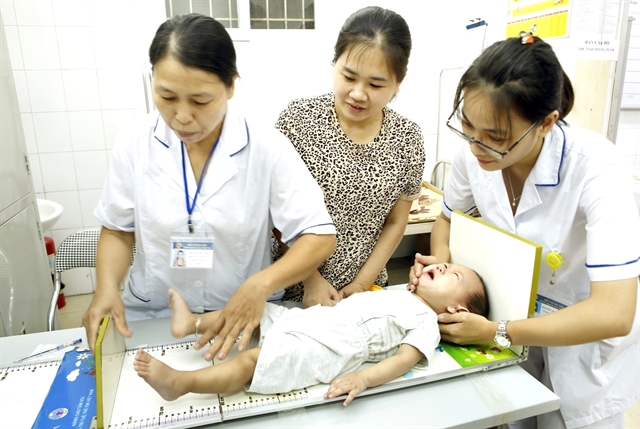 Society
Society

Hà Nội is rolling out various mechanisms, policies, communications activities and solutions to give the best care for children towards fulfilling child nutrition targets.

|
| A boy is measured at Healthcare Centre of Nguyễn Du Ward in Hai Bà Trưng District, Hà Nội. — VNA/VNS Photo Dương Ngọc |
HÀ NỘI — Hà Nội is rolling out various mechanisms, policies, communications activities and solutions to give the best care for children towards fulfilling child nutrition targets.
The city aims to reduce the ratio of stunting among children under five years old to 11.8 per cent in 2025, and the ratio of underweight children in the group to 7.3 per cent. The figures are hoped to fall to 11.3 per cent and 6.8 per cent, respectively, by 2030.
The city also hopes to lower the ratio of low birth weight (under 2,500 grams) among newborns to 4 per cent in 2020 and 3.5 per cent in 2030, while bringing the ratio of obesity among children under five years old down to less than 10 per cent in the inner city and 5 per cent in suburban areas in 2025.
In addition, the capital will strive to have 80 per cent of mothers breastfeed their child in the first hour after birth in 2025 and 85 per cent in 2030, along with 25 per cent of mothers practise exclusive breastfeeding in the first six months in 2025 and 30 per cent in 2030, and 60 per cent of mothers continue to nurse to 24 months and longer in 2025 and 80 per cent in 2030.
Việt Nam has seen the ratio of stunting among children under five years old reduce in recent years, but the ratio remains high at 23.2 per cent as of 2018.
The gap also remains big between mountainous and plain regions and between rural and urban areas.
The ratio is 28.4 per cent in a northern mountainous region and 32.7 per cent in the Central Highlands. Malnutrition and the shortage of micronutrients are among the major reasons for the modest height of Vietnamese youngsters.
In 2019, Hà Nội's health care sector managed to reduce the ratio of stunted children by 0.7 per cent to 12.8 per cent, and the ratio of underweight children by 0.3 per cent to 8.2 per cent.
The city has also focused on implementing measures to control obesity and raise public awareness and knowledge of proper nutrition among pregnant women and mothers, and making family meals more balanced to improve the population’s physical stature and strength.
In the future, the capital's health care sector will build a nutrition monitoring system from city to communal levels, while updating and analysing nutrition-related data and enhancing the capacity of protective medicine agencies.
The city will also popularise knowledge on proper nutrition among the community, thus changing people's habits and bettering their nutrition practices.
The municipal Department of Health has assigned disease control centres across the city to give technical guidelines and training to centres in localities to improve community nutrition.
It has built a nutrition monitoring and reporting system from the city to health care stations in communes, wards and towns while guiding health education and communications system to increase activities to popularise proper nutrition practices in the community.
Since 2019, the city Centre for Disease Control has worked with health care centres in districts and towns to launch communication campaigns to respond to the Week for Nutrition and Development, the Iodine Salt Day and Macronutrient Day.
Health education has been given to the community, while medical workers have also received training on the significance of proper nutrition in preventing non-transmittable chronic diseases and the lack of macronutrients.
Interference activities to reduce the number of stunted children have been implemented in 50 communes with more than 18 per cent of children suffering from stunted growth, while surveys on nutrition conditions among children under five years old and women at reproductive age have been carried out in 90 residential areas in two outskirt districts and some inner districts.
The city has also maintained activities to reduce obesity among primary school children. — VNS




